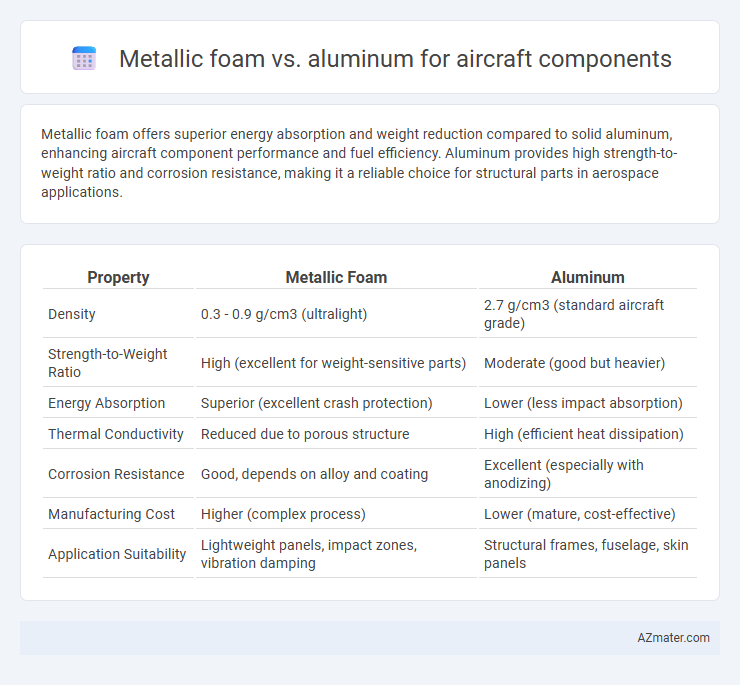Metallic foam offers superior energy absorption and weight reduction compared to solid aluminum, enhancing aircraft component performance and fuel efficiency. Aluminum provides high strength-to-weight ratio and corrosion resistance, making it a reliable choice for structural parts in aerospace applications.
Table of Comparison
| Property | Metallic Foam | Aluminum |
|---|---|---|
| Density | 0.3 - 0.9 g/cm3 (ultralight) | 2.7 g/cm3 (standard aircraft grade) |
| Strength-to-Weight Ratio | High (excellent for weight-sensitive parts) | Moderate (good but heavier) |
| Energy Absorption | Superior (excellent crash protection) | Lower (less impact absorption) |
| Thermal Conductivity | Reduced due to porous structure | High (efficient heat dissipation) |
| Corrosion Resistance | Good, depends on alloy and coating | Excellent (especially with anodizing) |
| Manufacturing Cost | Higher (complex process) | Lower (mature, cost-effective) |
| Application Suitability | Lightweight panels, impact zones, vibration damping | Structural frames, fuselage, skin panels |
Introduction to Advanced Aircraft Materials
Metallic foam offers superior energy absorption and weight reduction compared to traditional aluminum alloys commonly used in aircraft components, enhancing crashworthiness and fuel efficiency. Advanced aircraft materials leverage metallic foam's high strength-to-weight ratio and thermal insulation properties to improve overall structural performance. Incorporating metallic foam in aerospace design supports next-generation lightweight, durable, and damage-tolerant components essential for modern aviation innovation.
Understanding Metallic Foam: Structure and Properties
Metallic foam, characterized by its interconnected porous structure, offers exceptional strength-to-weight ratio and enhanced energy absorption compared to solid aluminum, making it ideal for aircraft components requiring lightweight and impact resistance. Its cellular architecture provides superior thermal insulation and vibration damping, improving aircraft performance and durability. Aluminum, while lightweight and corrosion-resistant, lacks the porous framework of metallic foam, resulting in lower energy absorption and thermal management capabilities.
Aluminum in Aerospace: Strengths and Limitations
Aluminum alloys dominate aerospace applications due to their exceptional strength-to-weight ratio, corrosion resistance, and ease of fabrication. While metallic foam offers significant weight reduction and energy absorption properties, aluminum's proven structural integrity and fatigue resistance make it more suitable for critical aircraft components. Limitations of aluminum include susceptibility to stress corrosion cracking and lower energy absorption compared to advanced composites or metallic foams, necessitating careful material selection in aerospace design.
Weight Comparison: Metallic Foam vs Aluminum
Metallic foam offers a significant weight reduction compared to traditional aluminum due to its porous structure, typically achieving densities as low as 0.2 to 0.5 g/cm3 versus aluminum's 2.7 g/cm3. This lightweight characteristic enhances fuel efficiency and payload capacity in aircraft components without drastically compromising strength. While aluminum remains widely used for its balance of strength and weight, metallic foam's optimized density presents a promising alternative for advanced aerospace applications requiring ultra-light materials.
Impact Resistance and Crashworthiness
Metallic foam exhibits superior impact resistance for aircraft components due to its energy-absorbing cellular structure, effectively reducing crash forces and enhancing crashworthiness compared to solid aluminum. The foam's porous matrix dissipates kinetic energy through progressive deformation, significantly improving occupant protection during impact events. Aluminum, while strong and lightweight, lacks the same level of energy absorption, making metallic foam a preferred material for critical safety applications in aerospace engineering.
Thermal Performance in Aviation Environments
Metallic foam exhibits superior thermal insulation properties compared to solid aluminum, significantly reducing heat transfer in aircraft components exposed to extreme temperature fluctuations. Its porous structure enhances thermal energy dissipation, improving temperature regulation and preventing hotspots in critical aviation systems. Aluminum offers high thermal conductivity but lacks the insulating advantage of metallic foam, making foam composites ideal for lightweight, thermally efficient aerospace applications.
Corrosion Resistance and Longevity
Metallic foam offers superior corrosion resistance compared to traditional aluminum, due to its unique porous structure that allows for better protective coatings and reduced moisture retention. Aluminum, while lightweight and strong, is more susceptible to corrosion in harsh environments, often requiring additional surface treatments to extend its lifespan. The enhanced corrosion resistance of metallic foam contributes to improved longevity and reduced maintenance costs in aircraft components.
Manufacturing Processes and Scalability
Metallic foam offers lightweight and high energy absorption properties ideal for aircraft components, produced mainly through powder metallurgy, investment casting, or replication methods, which can be complex and less scalable. Aluminum components benefit from well-established manufacturing processes such as extrusion, forging, and machining, providing high scalability and cost-efficiency for mass production. The integration of metallic foam in aircraft manufacturing faces challenges in process standardization and scalability, whereas aluminum remains the preferred choice due to mature industrial infrastructure and supply chain.
Cost Analysis: Initial and Lifecycle Expenses
Metallic foam offers weight reduction benefits that can lead to significant fuel savings over an aircraft's operational life, potentially offsetting higher initial manufacturing costs compared to aluminum. Aluminum's well-established production processes provide lower upfront expenses, but its higher density results in increased fuel consumption and maintenance costs throughout the lifecycle. Lifecycle cost analysis reveals that while metallic foam components demand greater initial investment, their enhanced strength-to-weight ratio and corrosion resistance contribute to reduced maintenance and operational expenses, improving total cost efficiency for aircraft manufacturers.
Future Prospects and Trends in Aircraft Material Selection
Metallic foam offers promising advantages over traditional aluminum in aircraft components due to its superior strength-to-weight ratio, energy absorption, and thermal insulation properties, making it ideal for future lightweight and impact-resistant structures. Advancements in manufacturing techniques are lowering costs and enabling precise control over foam density and cell structure, which enhances performance and broadens its application potential in aerospace design. Increasing emphasis on sustainability and fuel efficiency drives the trend toward integrating metallic foam composites alongside aluminum alloys, positioning them as critical materials in next-generation aircraft development.

Infographic: Metallic foam vs Aluminum for Aircraft component
 azmater.com
azmater.com